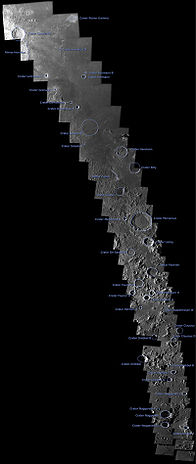Smart-1 probe ends mission with planned crash into the Moon
Tuesday, September 5, 2006
Observatories around the world watched the skies early on Sunday morning as a European space probe, the SMART-1 crash landed on the Moon; the first time a European made object has landed there and, as the first, it made quite a bang. For the culmination of its three-year mission the probe left its orbit around our nearest neighbor and smashed into the Lake of Excellence at around 4,500 mph. The impact created a brand new crater and scattered debris up to 30 miles, in contrast to the gentle touchdown of the Eagle lander (when Neil Armstrong became the first man on the moon) 37 years ago.
SMART

SMART-1, an unmanned probe, was launched aboard an Ariane 5 rocket on September 27, 2003 from the European Space Agency's launch site in Kourou, French Guiana. The first probe from the Small Missions for Advanced Research in Technology (SMART) group took 14 months to reach its destination. Since then it has orbited more than 3000 times, covering a staggering 62 million miles. In that time its mission has been to gather new information about the Moon's geographical and chemical make up. An ESA scientist, Bernard Foing said: "The legacy left by the huge wealth of SMART-1 data, to be analysed in the months and years to come, is a precious contribution to Lunar science at a time when the exploration of the Moon is once again getting the worlds interest." Using X-ray and infrared cameras the probe took pictures of the Moon's surface; some of its findings include a mountaintop (christened the Peak of Eternal light) where the Sun never sets.
Considering the distance it had traveled, the fuel consumption of SMART-1 was quite economical: the entire mission required just 62 litres (13 gallons) of liquid Xenon to fuel it. Weighing in at 376 kilograms and costing £75 million, SMART-1 was one of the smallest and cheapest space missions. Towards the end of its mission the probe was orbiting up to 4 times a day (as opposed to twice a day at the start of its mission) as controllers brought it closer and closer to the Moon in preparation for the final act.
New technology
The mission was also a test of new technologies. The miniature X-ray camera is the first in the world to be able to identify Calcium deposits in rock formations. Combined with other features the probe was, for the first time, able to map the chemical structure of large sections of the Lunar landscape. Manuel Grande, the University of Wales scientist in charge of the camera, said: "What was particularly pleasing was the calcium signal [...] This is the first time we've been able to take an inventory of all the rock-forming elements of the moon."
A similar camera is expected to be included on a similar Indian mission, the Chandrayaan-1, due to be launched in 2007-2008.
Another new technology used by the probe was its engine, called a Hall effect thruster, a new form of {{w|Ion thruster]] (first considered by scientists in the 1950's). Previously this type of engine was only flown on Russian satellites, and this was the first time one has ever powered a craft beyond earth orbit. The thruster works by applying a large voltage across a magnetic coil, creating a strong magnetic field. This ionises the Xenon fuel supply which accelerates the ions to high speeds, pushing the craft forward. The propulsion of such an engine is around 3 times that of a normal chemical rocket. The thruster was powered by 2 solar panels on either side of the probe.
The engine's small size and cost-efficiency helped keep down the mission budget. However there are drawbacks; for example, manoeuvres have to be carried out in long progressive burns rather than with short sharp bursts. A hall effect engine will also be used on the Bepi-Colombo mission to Mercury in 2013.
Earth observations
Astronomers and scientists in ground observatories tracked the crash landing as it unfolded, controlled by the ESA staff from the Darmstadt centre, Germany. The Mauna Kea Observatory in Hawaii caught the impact on infrared cameras, seen as a bright flash as rock and soil became superheated. Elsewhere, results were less conclusive; in Florida thick clouds meant astronomers missed the event. One observer said: "It would have been nice if it was clear, but that's the way astronomy works."
Success
ESA sources say the mission was entirely successful in its aim to test new technology and obtain more data about the Moon. "It was really a great mission for the agency," said mission manager Gerhard Schwehm, "It was a technology demonstrator that grew up and provide lots of beautiful science data."
Sister links
Sources
- Jacqui Goddard. "One giant lump from mankind" — The Times, September 4, 2006
- Mark Henderson. "Our closest neighbour remains an enigma" — The Times, September 4, 2006
- David McHugh. "European Probe Sends Back Data on Moon" — Associated Press, September 4, 2006
- Press Release: "SMART-1 impact update" — European Space Agency, September 3, 2006
| |
This page has been automatically archived by a robot, and is no longer publicly editable.
Got a correction? Add the template {{editprotected}} to the talk page along with your corrections, and it will be brought to the attention of the administrators. Please note that the listed sources may no longer be available online. |



